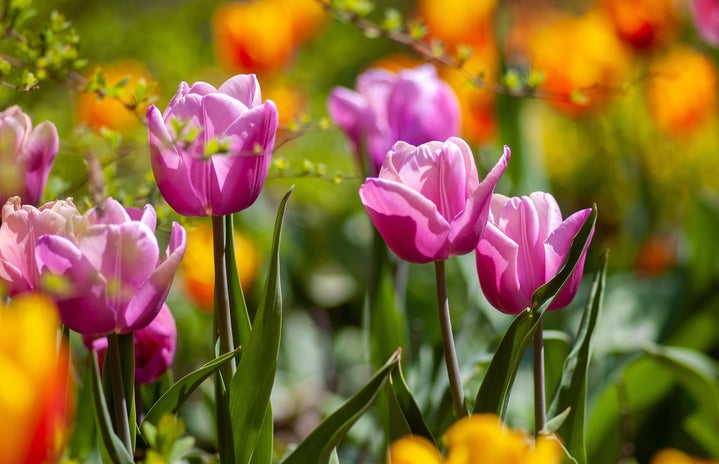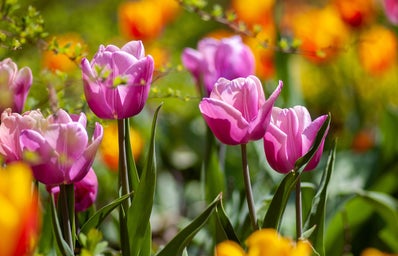As the days become longer and the temperature rises, Mother Nature begins to signal to the start of spring. When lockdown was implemented almost a year ago, many people began spending more time outdoors and many even started to garden. The joy from cultivating your own garden and tending to plants presents itself as both an effective stress management outlet and as an environmentally conscious hobby. Personally, for me, I have developed a passion for my plants (I currently have ten greenhouse plants in my room) and hope to further this passion even more this season. The spring and summer planting seasons are long and bountiful; however, it is important to start planning now to ensure your garden’s success. Whether it is annuals, perennials, vegetables or herbs, here are some popular plants to consider for your garden this season!
1. Lantanas
Over the years, lantanas have become one of my more favorite gardening plants because of their delicate shape and vibrant colors, as well as their ability to attract butterflies. Lantanas can either be annuals (plants that complete their life cycle in one growing season) or perennials (plants that rebloom each year). This depends on the hardiness zone of your region; however, in Northern Virginia, lantanas are typically annuals. They are also relatively easy to care for and do best with full sun. Depending on where lantanas are planted, their watering schedule can differ as lantanas in the ground typically only need to be watered once a week while lantanas in hanging baskets might need to be watered more frequently. In order to test when to water, you can feel one to two inches of the soil and if it is wet, allow the plant to dry in order to avoid root rot.
2. Chocolate Mint
One unique herb to add to your garden is chocolate mint. Like most herbs, chocolate mint does best in full sun to part shade and is well acclimated to Northern Virginia’s hardiness zone. Chocolate mint is also known to spread relatively fast so it is recommended that it is potted. If it is potted, it is important to monitor the soil’s moisture as it should not be completely dry. In order to also encourage growth, it is also recommended that you pinch the top of your chocolate mint, which means to essentially prune the tip of the plant. When the chocolate mint reaches to about four or five inches tall, you can start to harvest the plant but make sure to not take more than one third of the leaves. Chocolate mint is a great ingredient for tea, essential oils, and my favorite, ice cream!
3. Coleus
Coleus are different from lantanas and chocolate mint in that this plant typically prefers more shaded environments. They are native to tropical areas and thus flourish in the humidity, as well as consistently moist soil. This annual is known for its vibrant, unique and varied foliage and patterns; however, they can also occasionally flower. There are many variations of coleus and the colors most often incorporated include deep purple and bright green shades. Coleus are often used as bedding plants and thrive in both hanging baskets and custom annual pots.
4. Snapdragons
Like lantanas, snapdragons are another one of my more favorite flowering annuals. They are often a garden staple for their distinctive flower shape and rich colors. These annuals also prefer full sun to partial shade; however, they do not like overly hot climates. This means that snapdragons are a great option for the early stages of your spring garden. Their growth is predominantly vertical so like chocolate mint, pinching is recommended in order to achieve the plant’s full potential. Similar to the coleus as well, there are many different variations that come in a multitude of colors, as well as different lengths. The watering of snapdragons typically requires one inch of water per week so the soil’s moisture level should be monitored closely.
5. Jalapeno
To add a vegetable to the list, I have always had immense success with jalapenos. Jalapenos thrive in full sun and it is imperative that they are potted/planted in soil that allows for proper draining. The soil should not be saturated and instead, should be relatively moist. Since they are vegetables, it is important to be weary of any pests or diseases. Aphids are frequent pests in vegetable gardens; however, there are many different organic sprays that can help fight possible infestations. Another important factor to note is that typically with vegetables, cages or stakes are needed in order to keep the plants upright. These are very common to find at any nursery and are relatively inexpensive.
Although these plants are all great options, it is also important to plan out how much time and effort you are willing to put into your garden. This includes researching what plants do best given your region’s hardiness zone, as well as understanding the typical rainfall and sunlight of your garden’s location. Combining research and hard work can allow for your garden to thrive to its highest potential and hopefully you can discover some of your favorite spring plants through this process!



